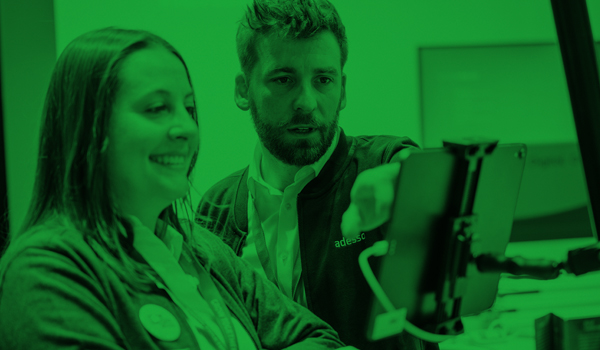Stryker relies on the Natuvion DCS for its move to SAP S/4HANA
Stryker, the world-leading medical technology company, recently completed the modernization of its systems and the transition to SAP S/4HANA. The...
8 min read
 Philipp von der Brüggen
:
Jul 21, '25
Philipp von der Brüggen
:
Jul 21, '25

Almost two and a half years after SAP announced the sunset of its industry solution SAP IS-H, hospitals in Germany are still searching for a viable and future-proof alternative. While several hospital information system (HIS) providers have announced new solutions, there’s little more than a few pilot projects on record so far. In the DACH (German-speaking) region alone, over 500 hospitals still rely on IS-H for billing and patient management—it’s a core component of SAP ECC, which itself must be replaced by 2027. This creates a double challenge for healthcare providers. Philipp von der Brüggen (CMO, Natuvion) spoke with Gerrit Schröder (Principal Consultant at adesso business consulting AG) and Burkhard Hergenhan (Head of Public Business, Natuvion) about the dilemma.
Gerrit Schröder: The most probable reason is that SAP is a global company focusing on core modules like financial accounting and controlling — things every industry needs. In contrast, a solution like IS-H has to be customized for each country’s specific healthcare regulations and practices. That’s a niche business and requires far more investment compared to SAP’s standard modules. The healthcare market is also highly regulated. New requirements for IT systems are introduced frequently and must be implemented quickly. That makes IS-H a very maintenance-heavy application. Ultimately, SAP likely weighed the cost-benefit ratio and decided it wasn’t worth continuing.
Gerrit Schröder: I wouldn’t say that. IS-H is still very widespread and well established — there’s definitely commercial value there. But SAP’s overall strategy has shifted. They’re evolving from a modular software provider to a cloud-based platform, offering more standardized processes. But standardization often conflicts with how hospitals work. Hospital processes vary significantly and aren’t harmonized across the board.
Burkhard Hergenhan: One point I want to clarify, since it’s often misunderstood, is that SAP IS-H and i.s.h.med are two different applications. Both run on SAP ECC and are closely integrated, but while IS-H handles billing, i.s.h.med is used for clinical documentation. i.s.h.med, however, is now part of Oracle Health. It’s important to distinguish between the two.
Gerrit Schröder: Hospitals have so far used a fully integrated ECC system with IS-H and i.s.h.med. Now they must replace both ECC and IS-H. Some non-SAP vendors are stepping in with potential successor solutions — especially vendors who previously only provided clinical documentation modules. They're now developing billing modules with interfaces to SAP systems. But choosing a future ERP system is a decision each hospital must make individually.
Gerrit Schröder: In some cases, yes. A few hospitals are evaluating a complete break from SAP. But we’re not seeing widespread moves in that direction. Most customers are currently looking for a one-to-one IS-H replacement or a way to integrate billing into their HIS.
Gerrit Schröder: In most cases, hospitals run the core modules of SAP R/3 ECC — typically Materials Management (MM) and Financials (FI/CO). On top of that, they use SAP IS-H and i.s.h.med, which are also based on the same underlying technology stack and database. They may also be using additional modules, such as Human Capital Management (HCM).
Burkhard Hergenhan: Our current 2025 Transformation Study shows that these projects take between 1.5 to 2.5 years on average. Complicating things further, healthcare institutions are often publicly owned, which means consultants and new solutions have to go through public tendering—slowing things down.
Gerrit Schröder: Absolutely. Hospitals need to be careful not to run out of time. One technical option is to move core modules to SAP S/4HANA and keep IS-H and i.s.h.med running on ECC using a connector. That would divide the transition into smaller phases.
Burkhard Hergenhan: Still, the core challenge remains: what do I do with my i.s.h.med system?
Gerrit Schröder: Exactly! There are a few different scenarios emerging now. But it really depends on the structure of the hospital. For i.s.h.med, Oracle Health has announced a one-to-one replacement. However, this would require a migration to Oracle’s cloud infrastructure. In that case, hospitals would receive extended support for Oracle’s two core solutions and eventually transition to Oracle’s successor platform. That’s one possible scenario.
For hospitals not using i.s.h.med, another option is to rely on their current HIS (Hospital Information System) provider to deliver the billing functionality — ideally integrated with SAP S/4HANA. For those still running SAP IS-H, it appears there will be two partner solutions available as migration paths. These are the main directions currently being discussed in the healthcare sector.
Burkhard Hergenhan: It’s important to note, though, that none of these solutions has reached a level of maturity that would allow a one-to-one migration today. They’re still in the pilot phase. The vendors have partnered with hospitals to replicate and test IS-H components — and that’s where things currently stand. No one really knows yet which solution can be migrated to and how. That’s the big unknown.
Gerrit Schröder: Exactly. Hospitals don’t know what the “other side” will ultimately look like. There's no way to run a proper test transformation yet. The required maturity simply isn’t there. But if a hospital has already transformed its core system and implemented a temporary workaround for IS-H and i.s.h.med, it could take the time to evaluate the available partner solutions more carefully.
Burkhard Hergenhan: In principle, that’s certainly possible. You can switch vendors altogether. But moving away from SAP entirely would mean abandoning the extensive know-how that exists within a hospital organization that has been trained and optimized around SAP systems. That starts with financial accounting and extends all the way through to the nursing staff. Everyone would need to be retrained. And all of this against the backdrop of the intense time pressure we’ve already discussed. I think that’s nearly impossible.
Gerrit Schröder: That’s exactly right. And real clarity will only come once there’s a comparable hospital that has successfully implemented one of these new solutions in live operations. Only then will others be confident that it actually works.
That’s why a step-by-step approach makes sense. Many organizations are already taking the opportunity to transform their core systems now. They continue to run only the components they still need to operate IS-H and i.s.h.med. These must be maintained in a state that allows them to remain under extended maintenance. That buys hospitals some time — time to wait for the new solutions to mature. And it also allows organizations to get a head start on parts of the overall transformation.
Burkhard Hergenhan: I strongly advise organizations to start working on their requirements now. That way, they’ll already have a clear concept in place once the new solutions are market-ready. But one thing should be made very clear: extended maintenance is ultimately just a temporary workaround. It ensures the application remains operable and continues receiving security updates — nothing more.
If a major healthcare reform is introduced — for example, changing billing structures that would require adjustments in IS-H — you won’t be on safe ground. No one knows whether such requirements will still be implemented and delivered under extended maintenance.
Gerrit Schröder: That’s where experienced transformation specialists like Natuvion or adesso come in. There are several ways to migrate data — but a brownfield approach simply isn’t possible, because IS-H doesn’t exist on the S/4HANA side. So that leaves options like a shell conversion, a “mix and match” strategy, or a greenfield approach.
The greenfield route is quite appealing. Hospitals could start fresh — essentially on a blank slate. But you have to realize that the healthcare IT landscape is full of heavily customized, deeply embedded systems. In many cases, the processes are older than the users themselves. For years, there’s been little consideration about whether or how to optimize these processes. That’s why greenfield would be ideal. The only issue is that hospitals can’t simply abandon their patient data. Think about chronically ill patients — you can’t just cut off their medical history.
Gerrit Schröder: Exactly. If I need to retain certain patient data, the only path forward is a “greenfield plus” approach or a selective data migration. One idea would be to migrate the last few years of data and archive the rest.
Burkhard Hergenhan: That’s especially important given that health insurers in Germany, for example, can challenge and demand corrections to invoices going back five years. If billing data needs to be corrected, users can’t do that from an archive system — they need a fully operational system. That’s the only way corrections can actually be made.
Gerrit Schröder: The biggest issue is that we’re dealing with highly sensitive data — medical records. These are people’s health histories. It must be absolutely guaranteed that no data is lost or falls into the wrong hands. That means the highest security standards must apply, and only professionals with real expertise should handle these migrations.
Burkhard Hergenhan: Another challenge is the legacy nature of many of these systems. They’re often highly customized and lack standardization. Just look at the landscape: we’ve got university hospitals, hospital chains, municipal clinics, rural hospitals, rehab centers with or without acute care, geriatric facilities — you name it. Hardly any two organizations are alike. And their systems have been individually tailored over many years. That makes standardized migration procedures incredibly difficult and inherently complex.
Gerrit Schröder: Many organizations are actively engaging with the transformation topic. Some can even be considered pioneers — they’ve already completed their core S/4HANA migration and are now preparing for the IS-H and/or i.s.h.med transition.
We’re also seeing a lot of pre-projects and tenders being launched. But understandably, everyone is somewhat in a holding pattern when it comes to the future of IS-H. And we should put ourselves in the shoes of these IT leaders. Making these decisions isn’t easy — especially when hospitals are chronically underfunded and understaffed.
Let’s not forget: they’ve just been through a pandemic. Most have been operating in crisis mode. And the aftermath is still being felt. I see it every day — staff working constant overtime just to keep systems running. And now they’re supposed to pull off a complex transformation on top of that? That’s a massive challenge.
Burkhard Hergenhan: When I look at how many hospitals haven’t even started the transformation, and compare that to how few consulting firms there are with the necessary expertise, I have to admit I’m a bit worried.
I fear that many organizations will miss the opportunity to truly leverage the benefits of transformation, simply because they lack the time and experience. Eventually, we’ll see a “rush job” — quick-and-dirty migrations just to get it over with. That means the chance to rethink and improve processes will be lost. And in some hospitals, that would be a disaster.
We still see a lot of paper-based workflows that will later require expensive efforts to re-digitize. If those don’t get addressed during the transformation, that’s a huge missed opportunity to optimize operations at scale.
In any case, no one knows when vendors will bring a mature successor to IS-H to market — or how much time will be left to act. It’s going to be a tense race.
Gerrit Schröder: That’s why my recommendation is clear: hospitals need to start engaging with the transformation process now. Ideally, they should already be in a pre-project phase with an experienced consultancy like Natuvion or adesso, working out what’s necessary, possible, and meaningful — and defining their future roadmap.
They also need to free up resources early and prepare their organizations. This is no small task — it will fundamentally impact how these institutions operate in the future. And hospitals must understand that an IT transformation is not just a technical project – it affects everyone working there.
Thank you both for the insightful conversation!

Stryker, the world-leading medical technology company, recently completed the modernization of its systems and the transition to SAP S/4HANA. The...

Digital transformation in the public sector is often a tough, slow-moving project, and many government agencies are still far from where they need to...

Walldorf, Germany, Nov 18, 2025 – Data transformation specialist Natuvion has expanded its partner program by integrating its data transformation...